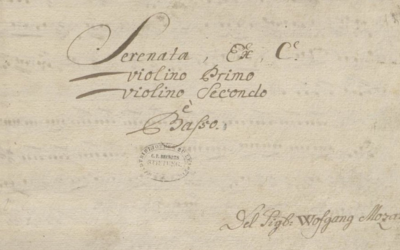K.143
A Recitative and Aria in the Shadows of Doubt
Ergo interest, Quaere superna—a Latin recitative and aria in G major, supposedly by the young Wolfgang Amadeus Mozart. It is catalogued as K.143 (73a), but its attribution is fraught with uncertainties that would make even the staunchest Mozart devotee hesitate. This “work” is a case study in how musicology has built entire legends on quicksand, blithely ignoring gaping holes in the narrative.
Mozart in Italy: The Untold Story
Was Mozart truly a solitary genius, or was he merely the instrument of his father’s ambition? “Mozart in Italy” challenges the conventional narrative, revealing a complex dynamic between father and son that shaped the course of music history. Prepare to question everything you thought you knew.
“Sometimes, the most convincing attribution is simply the one no one dares to question.”
Mozart in Italy
A Patchwork of Guesses
The sole surviving manuscript, housed in the Library of Congress, is attributed to Mozart with more hope than evidence. Key details are conspicuously absent: no date, no clear author, no definitive instrumentation. Even the watermark of the manuscript, often a vital clue for authentication, has vanished. Adding to the enigma, there are no other copies or printed editions, and the identity of the text’s author is unknown.
Yet, the piece was included in the first Köchel catalogue with a speculative date: Salzburg or Milan, 1772–1773. This guesswork has since ossified into “fact” for many scholars. But here’s the kicker: the manuscript is a so-called “fair copy,” combining the handwriting of both Wolfgang and Leopold Mozart. The pristine condition of the manuscript screams preparation for presentation, not original composition. Are we really to believe that this uninspired recitative and aria were the work of the teenage prodigy at the height of his creative vigor?
The “Gentle Melodic Contours” of… Someone Else?
Advocates for Mozart’s authorship point to a letter Leopold Mozart wrote in Milan on February 3, 1770, where he mentions two motets composed by Wolfgang for castrati. However, the stylistic features of K.143 reveal nothing uniquely Mozartian. Instead, the music adheres rigidly to the Italian church style of the period, showing “hardly any individual traits.” This blandness alone should raise eyebrows. Could this be a rushed transcription of another composer’s work? The suggestion, while plausible, has been curiously dismissed without serious consideration.
Some argue that Mozart’s copies of sacred works often served pedagogical purposes. But K.143 lacks the depth or ingenuity to justify such an effort. Why would a budding genius waste time copying an uninspired motet? The piece neither challenges compositional norms nor offers any discernible expressive innovation.
The Elephant in the Room
What if K.143 isn’t Mozart’s at all? This hypothesis—likely the most straightforward explanation—has been conveniently ignored. Why? Because it challenges the sacrosanct image of Mozart as a prodigious composer, churning out masterpieces at every turn. Yet the evidence (or lack thereof) makes a compelling case: K.143 is probably a sloppy patchwork cobbled together by Leopold, using Wolfgang’s handwriting to pass it off as the son’s work. This would not be the first time Leopold blurred the lines of authorship to advance his son’s career.
The refusal to entertain this possibility exposes the bias entrenched in Mozart scholarship. Instead of grappling with the uncomfortable uncertainties surrounding K.143, musicologists have leaned on circular reasoning and vague stylistic comparisons to maintain its place in Mozart’s oeuvre.
A Final Note of Dissonance
K.143 serves as a stark reminder of how little we truly know about Mozart’s catalog. If this uninspired piece can be so confidently attributed to him without solid evidence, how many other “Mozartian” works are similarly dubious? Perhaps it is time to admit that the emperor—or in this case, the child prodigy—might not always have been wearing any clothes.
You May Also Like
Mozart’s Serenade? A New Discovery? Really?
In Leipzig, what was thought to be a new autograph of Mozart turned out to be a questionable copy. Why are such rushed attributions so common for Mozart, and why is it so hard to correct them when proven false?
Mozart’s K 71: A Fragment Shrouded in Doubt and Uncertainty
Mozart’s K 71, an incomplete aria, is yet another example of musical ambiguity. The fragment’s authorship, dating, and even its very existence as a genuine Mozart work remain open to question. With no definitive evidence, how can this fragment be so confidently attributed to him?
Unpacking Mozart’s Early Education
The story of Ligniville illustrates the pitfalls of romanticizing Mozart’s early life and education, reminding us that the narrative of genius is often a construct that obscures the laborious aspects of musical development.
The False Sonnet of Corilla Olimpica
Leopold Mozart’s relentless pursuit of fame for his son Wolfgang led to questionable tactics, including fabricating a sonnet by the renowned poetess Corilla Olimpica. This desperate attempt to elevate Wolfgang’s reputation casts a shadow over the Mozart legacy.
Mozart’s K 73A: A Mystery Wrapped in Ambiguity
K.143 is a prime example of how Mozart scholarship has turned uncertainty into myth. With no definitive evidence of authorship, date, or purpose, this uninspired recitative and aria in G major likely originated elsewhere. Is it time to admit this is not Mozart’s work at all?
A Farce of Honour in Mozart’s Time
By the time Wolfgang Amadeus Mozart received the Speron d’Oro, the once esteemed honour had become a laughable trinket, awarded through networking and influence rather than merit. Far from reflecting his musical genius, the title, shared with figures like Casanova, symbolised ridicule rather than respect.







